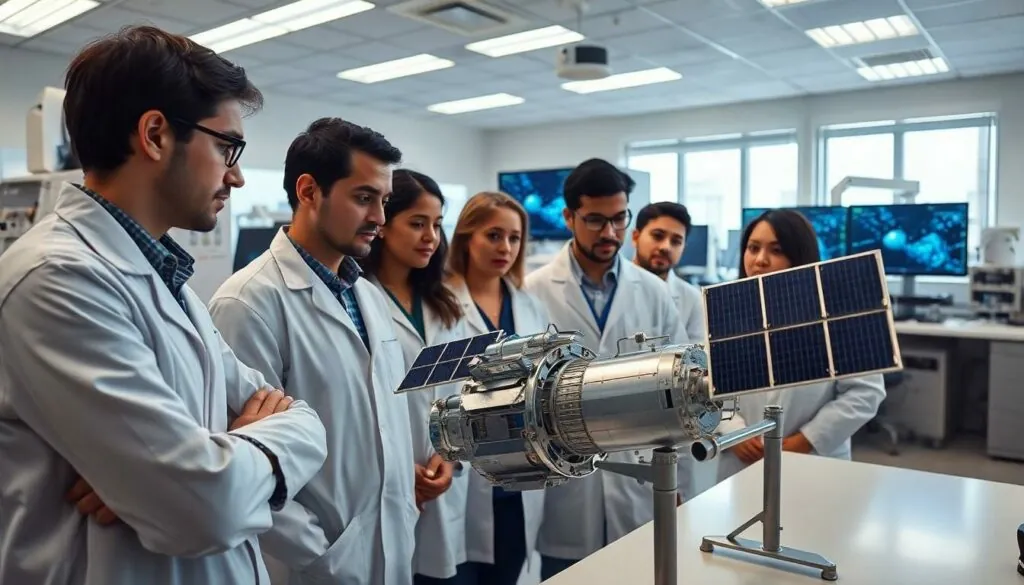Table of Contents
ToggleSpace technology isn’t just for astronauts and rocket scientists anymore. It’s the magic that makes everything from GPS navigation to satellite TV possible. Imagine trying to find a restaurant without your trusty smartphone guiding you—yikes! Space tech is woven into the fabric of daily life, and it’s not just about launching shuttles into the great unknown.
But what exactly is space technology? It’s a blend of engineering, physics, and a sprinkle of imagination that helps humanity explore beyond our blue planet. From satellites orbiting Earth to rovers roaming Mars, space technology fuels our curiosity and drives innovation. So buckle up as we take a fun ride through the cosmos of gadgets, gizmos, and groundbreaking discoveries that keep us connected and inspired.
What Is Space Technology?
Space technology refers to the tools, systems, and methods developed for use in space exploration and related applications. It includes a wide array of engineering disciplines and scientific principles that contribute to the functioning of satellites, spacecraft, and associated ground systems. Innovations in material science, propulsion, and communication systems form vital components of this technology.
Satellites play a crucial role in space technology, enhancing global communications, weather forecasting, and Earth observation. These satellites not only enable GPS navigation but also support scientific research and environmental monitoring. Such advancements demonstrate how integrated space technology is with everyday life.
Moreover, space technology fosters innovation in various sectors. Industries like telecommunications, aviation, and transportation benefit significantly from research and development in space. For instance, technologies initially created for space missions have led to the invention of numerous consumer products, from smoke detectors to water purification systems.
In addition to practical applications, space technology aims to inspire future generations. Educational programs and outreach initiatives centered around space exploration promote interest in science, technology, engineering, and mathematics (STEM). This focus cultivates a skilled workforce prepared to address contemporary challenges.
Investments in space technology continue to grow, reflecting its relevance in solving global issues. National governments and private enterprises collaborate in initiatives that expand the boundaries of space exploration, including missions to Mars and beyond. Each project showcases the potential of space technology to unlock new frontiers.
Key Components of Space Technology

Space technology involves several key components that facilitate exploration and numerous applications on Earth.
Satellites
Satellites play a pivotal role in modern communication, navigation, and Earth observation. They orbit the Earth and provide vital data for weather forecasting, global positioning systems, and telecommunications. More than 2,000 active satellites currently exist, significantly enhancing connectivity. These satellites also aid scientific research by acquiring data on climate change and natural disasters. GPS satellites alone have transformed navigation, enabling precise location tracking for various applications.
Launch Vehicles
Launch vehicles serve as the backbone of space missions, transporting payloads beyond Earth’s atmosphere. Rockets like SpaceX’s Falcon 9 and NASA’s Space Launch System deliver satellites, space probes, and crewed missions to orbit. Each launch vehicle features unique capabilities; for example, Falcon 9 offers reusability, reducing mission costs. The development of new technologies in launch vehicles continues to expand access to space, fostering innovation and collaboration across commercial and governmental sectors.
Space Probes
Space probes explore distant celestial bodies, providing invaluable insights into our solar system and beyond. NASA’s Voyager probes, launched in 1977, have ventured beyond the heliosphere, relaying crucial data about outer planets and interstellar space. Probes like the Mars Rover explore planetary surfaces, conducting experiments and sending images back to Earth. Each probe’s mission enhances understanding of planetary formation, fostering advancements in astrobiology and planetary science. Current projects aim to reach destinations like Europa and Titan, further unraveling the mysteries of the universe.
Applications of Space Technology
Space technology plays a critical role across various sectors, impacting daily life in ways often unnoticed. It fosters innovation in communication, Earth observation, and space exploration.
Communication
Satellites enhance global communication by enabling devices to transmit signals over long distances. Systems like GPS rely on a network of satellites to provide accurate positioning data. Innovations in satellite technology have led to improved internet connectivity, especially in remote areas. Hefty investments from both government and private sectors drive advancements in satellite systems. Modern communication technologies leverage low-Earth orbit satellites to improve service quality and lower latency.
Earth Observation
Earth observation satellites monitor environmental changes, weather patterns, and natural disasters. Data from these satellites aids in agriculture, urban planning, and disaster response. They provide critical information for climate research, helping scientists analyze changes in the Earth’s atmosphere and surface. Satellites equipped with advanced sensors capture high-resolution images, supporting various industries in decision-making processes. Real-time data sharing enhances the ability of agencies to respond to emergencies effectively.
Space Exploration
Space exploration technologies open new frontiers in understanding the universe. Probes and rovers gather valuable data from distant celestial bodies, significantly expanding knowledge of planetary science. Missions targeting Mars and the outer planets underline the importance of these technologies in unraveling cosmic mysteries. Robotic spacecraft are essential for collecting samples and conducting experiments in extreme environments. Collaboration among international space agencies promotes shared goals for deep space exploration, nurturing advancements in engineering and science.
The Future of Space Technology
Exploring the future of space technology reveals exciting developments. Innovations continue to emerge as industries collaborate on expanding possibilities.
Innovations on the Horizon
Advancements in space technology emphasize reusable launch systems, which decrease mission costs and increase efficiency. Artificial intelligence enhances satellite operations, enabling autonomous decision-making and data analysis. Small satellites, or CubeSats, are gaining traction for providing low-cost solutions for research and commercial purposes. These compact devices allow universities and startups to participate in space exploration. Additionally, lunar bases are under consideration for sustainable human presence on the Moon, serving as a launch point for deeper space missions. Various organizations are examining in-situ resource utilization, making it feasible to utilize local materials for fuel and construction. Each innovation opens new avenues for exploration and enhances overall mission potential.
Potential Challenges
Significant challenges accompany the expansion of space technology. Regulatory hurdles often impede the deployment of new satellites, particularly in crowded orbits. Debris in space poses risks to operational satellites and future missions; addressing this issue requires innovative solutions. Data security also becomes increasingly crucial as satellite networks expand, necessitating robust protections against cyber threats. Additionally, funding remains a barrier for many emerging companies, limiting their ability to innovate at scale. Public perception of space exploration plays a role in securing financial support; ensuring transparency and education will help build trust. Overcoming these challenges paves the way for the successful advancement of space technology.
Space technology is more than just a tool for exploration; it’s a vital part of modern life. From enhancing communication to monitoring environmental changes, its applications are vast and impactful. The innovations driven by space technology continue to inspire future generations and foster interest in STEM fields.
As investments in this area grow, the collaboration between governments and private enterprises promises to unlock new possibilities. The challenges ahead are significant, but the potential benefits of continued advancements in space technology could reshape our understanding of the universe and improve life on Earth. Embracing these developments will be crucial for harnessing the full power of what space technology can achieve.





